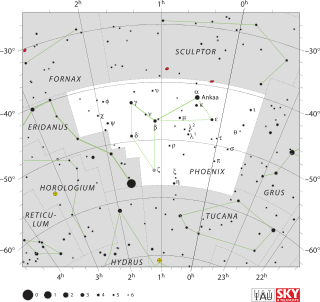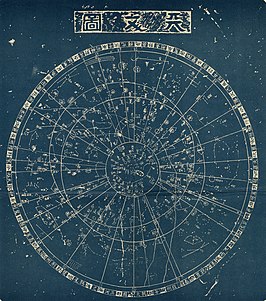Chinese star names are named according to ancient Chinese astronomy and astrology. The sky is divided into star mansions and asterisms. The system of 283 asterisms under Three Enclosures and Twenty-eight Mansions was established by Chen Zhuo of the Three Kingdoms period, who synthesized ancient constellations and the asterisms created by early astronomers Shi Shen, Gan De and Wuxian. Since the Han and Jin Dynasties, stars have been given reference numbers within their asterisms in a system similar to the Bayer or Flamsteed designations, so that individual stars can be identified. For example, Deneb is referred to as 天津四.
The modern constellation Andromeda lies across two of the quadrants, symbolized by the Black Tortoise of the North and the White Tiger of the West, that divide the sky in traditional Chinese uranography.
According to traditional Chinese uranography, the modern constellation Aquarius is located within the northern quadrant of the sky, which is symbolized as the Black Tortoise of the North.
The modern constellation Boötes lies across one of the quadrants symbolized by the Azure Dragon of the East, and Three Enclosures, that divide the sky in traditional Chinese uranography.
According to traditional Chinese uranography, the modern constellation Capricornus is located within the northern quadrant of the sky, which is symbolized as the Black Tortoise of the North
The modern constellation Centaurus lies across two of the quadrants symbolized by the Azure Dragon of the East, the Vermillion Bird of the South, and the Southern Asterisms.
The modern constellation Cetus lies across two of the quadrants, symbolized by the Black Tortoise of the North and the White Tiger of the West, that divide the sky in traditional Chinese uranography.
The modern constellation Coma Berenices lies across one of the quadrants symbolized by the Azure Dragon of the East, and Three Enclosures, that divide the sky in traditional Chinese uranography.
The modern constellation Draco lies across one of the quadrants symbolized by the Black Tortoise of the North, and Three Enclosures, that divide the sky in traditional Chinese uranography.
The modern constellation Eridanus lies across one of the quadrants symbolized by the White Tiger of the West, and The Southern Asterisms, that divide the sky in traditional Chinese uranography.
The modern constellation Leo lies across one of the quadrants symbolized by the Vermilion Bird of the South, and Three Enclosures, that divide the sky in traditional Chinese uranography.
According to traditional Chinese uranography, the modern constellation Libra is located within the eastern quadrant of the sky, which is symbolized as the Azure Dragon of the East.
The modern constellation Hydra lies across two of the quadrants, symbolized by the Azure Dragon of the East and the Vermilion Bird of the South, that divide the sky in traditional Chinese uranography.
The modern constellation Ophiuchus lies across two of the quadrants symbolized by the Azure Dragon of the East and The Black Tortoise of the North, and Three Enclosures, that divide the sky in traditional Chinese uranography.
The modern constellation Orion lies across two of the quadrants, symbolized by the White Tiger of the West and Vermilion Bird of the South, that divide the sky in traditional Chinese uranography.
According to traditional Chinese uranography, the modern constellation Pegasus is located within the northern quadrant of the sky, which is symbolized as the Black Tortoise of the North.
The name of the IAU constellation Scorpius in modern Chinese is 天蝎座.
The modern constellation Serpens lies across one of the quadrants, symbolized by the Azure Dragon of the East, and Three Enclosures, that divide the sky in traditional Chinese uranography.
According to traditional Chinese uranography, the modern constellation Taurus is located within the western quadrant of the sky, which is symbolized as the White Tiger of the West (西方白虎).
The modern constellation Virgo lies across one of the quadrants symbolized by the Azure Dragon of the East, and Three Enclosures, that divide the sky in traditional Chinese uranography.


